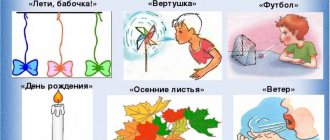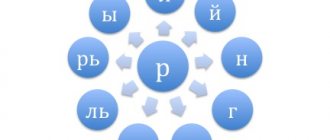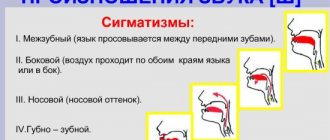Children under the age of 5-6 years should be able to independently pronounce all existing sounds. If this does not happen, parents need to independently train their child’s pronunciation at home or seek help from specialists in case of particularly obvious deviations from the norm. Setting and automating the sounds “R” and “R” is the most difficult task compared to the rest of the pronunciation of letters of the Russian alphabet.
Classification
Replacement (substitution) and confusion (interchange) of speech sounds are phonemic (sensory, phonological) defects, usually caused by incompleteness or disruption of the development of phonemic hearing.
Substitutions are classified into the same groups as distortions of sounds, only the prefix “para-” is added to the name of the latter: 1. Parasigmatisms
(from the Greek letter “sigma”) - replacements for whistling and hissing words:
- labial-dental - voiced [Z] and [Zh] are replaced by [V], unvoiced [S] and [Sh] - by [F] (“sleigh” - “fani”, “green” - “veleny”);
- prizubny - replacing [S] and [W] with [T], and [Z] and [Z] with [D] (“elephant” - “tlon”, “teeth” - “oaks”);
- hissing ‒ instead of [S] it is pronounced [Ш], instead of [Z] ‒ [Zh] (“sledge” - “shanki”, “bunny” - “zhaika”)
- whistling ‒ instead of [Ш] [S] is used, instead of [Z] ‒ [Z] (“washer” - “sayba”, “belly” - “yawn”).
2. Paralambdacisms
(from the letter of the Greek alphabet “lambda”) - replacing the sound [L] (“paw”) with [U] (“uapa”), [V] (“vapa”), [Y] (“yapa”), [L ′] (“blunder”), [P] (“rapa”), [Y] (“yapa”), [D] (“dapa”).
3. Pararotacisms
(from the Greek letter “rho”) - replacing the sound [P] (“hand”) with [P′] (“ryuk”), [L] and [L′] (“bow,” “luka”), [Y ] (“yuka”), [G] (“guka”), [D] (“duka”), [V] (wuka).
4. Paraiotacisms
(from the Greek “iota”) - replacing the sound [Y] with [L′] (“shirt” - “fry”).
5. Replacement of back-lingual sounds
(from the Greek letters “kappa”, “gamma”, “chi”): parakappacisms - [K] on [T] (“Kolya” - “Tolya”), paragammatisms – [G] on [D] (“head” - “dolova”), parachitisms - [X] on [T] (“tail” - “twist”).
Also in practical speech therapy, sound substitutions include voicing defects (replacement of voiced phonemes with paired voiceless ones - “kushi” instead of “geese”) and softening defects (replacement of soft consonants with their hard pairs - “tota” instead of “aunt”). Close to replacement is the mixing of sounds, i.e., mutual substitutability, confusion of phonemes.
Causes of functional dyslalia
Somatic Physical and neurological weakness due to long-term chronic diseases of the body (indigestion, frequent colds) Social
- Pedagogical neglect (parents do not correct deficiencies in their children’s speech and do not demonstrate examples of correct sound pronunciation).
- Bilingualism in the family (When parents speak different languages, the child inserts another into one language. For example, French + Russian = throat sound “R”).
- A sample of incorrect speech in a child’s environment (by imitation).
Incorrect articulation Selecting incorrect articulation Underdevelopment of phonemic hearing Physical hearing can be preserved, but phonemic hearing is impaired.
Reasons for replacing sounds
Physiological tongue-tiedness
Various types of sound replacement are most numerous during the period of age-related imperfections in sound pronunciation - the so-called physiological dyslalia. Substitutions occur in the speech development of all younger preschoolers; they are associated with the physiological immaturity of the articulatory apparatus and speech hearing.
The period of mastering sound in ontogenesis takes from 1-1.5 months or longer. It occurs in several stages. First, children use substitute sounds in speech. Then, having “found” the correct articulation and correlated the new sound with the acoustic model, the child begins to pronounce it in parallel with the old substitute sound. At the next stage, the new sound gradually displaces the substitute, after some time completely replacing it.
With physiological dyslalia, the following types of replacements are more common:
- replacing hard consonants with soft ones (“bow” - “hatch”);
- softening defects (“uncle” - “dada”);
- replacing hissing ones with whistling ones (“cat” - “koska”);
- pararotacisms (“cancer” - “lac”, “vac”, “yak”);
- paralambdacisms (“bun” ‒ “buika”, “beech”);
- posterior palatal defects.
Physiological imperfections of speech, and along with them sound substitutions during normal speech ontogenesis, disappear on their own by 4.5-5 years.
Functional dyslalia
The phenomenon of substitution is typical for the articulatory-phonemic and acoustic-phonemic forms of dyslalia. In the first case, the replacements are due to the immaturity of sound structures and the use in speech of phonemes that are simpler in articulation. In the second, speech hearing turns out to be undeveloped, as a result of which sounds are recognized incorrectly.
With functional dyslalia, hissing sounds are usually replaced by whistling sounds; sonors [P], [L], affricates [C], [H] – each other; posterior palatal - explosive anterior lingual; hard ones - their soft pairs. Such defects are not prone to disappear on their own and require speech therapy assistance to correct the FFN.
Dysarthria
Dysarthria is characterized by defects in softening, voicing, mixing of sounds, and undifferentiated articulation. Substitutions of sounds occur in large numbers in pseudobulbar, bulbar, cortical, and erased dysarthria.
Palatalization of consonants is associated with increased spasticity of the middle part of the back and tip of the tongue. Defects in voicing are explained by a violation of the voice, its insufficient strength. The consequence of articulatory dyspraxia is the specific replacement of consonants: [G] with [D], [K] with [T], [L′] with [Y], the use of simpler sounds instead of affricates - [Ts-S′], [H‒ T′], etc.
Rhinolalia
The open form of rhinolalia is more characterized by phonetic defects in sound pronunciation, however, in some cases, sound substitutions are also found. So instead of plosive consonants [B], [P], fricatives [V], [F] are used; instead of the vibrant [P], the vowel [Y] is pronounced with a strong exhalation, the whistling [S] is replaced with [F].
Specific are the replacement and mixing of sibilants and sibilants, simplification of affricates, the use of nasal consonants [M], [N] instead of [B] and [P]. With closed rhinolalia, on the contrary, nasal sounds are replaced by oral ones.
Sensory alalia
Violation of differentiated speech perception with sensory alalia leads to the same undifferentiated pronunciation of sounds and words. This form of speech disorder is characterized by unstable sound substitutions, i.e., each time the child pronounces, different substitutes are used. Sound substitutions are numerous and varied, combined with distortion of the syllabic structure of the word.
Aphasia
Substitutions of sounds and letters that occur during aphasia are called literal paraphasia. Such defects occur in acoustic-gnostic, afferent motor aphasia, when the “phoneme-articuleme-grapheme-lexeme” connection disintegrates.
In the sensory form of aphasia, the patient's acoustic gnosis is disrupted, and speech sounds are no longer distinguishable by ear. This leads to the replacement of phonemically close sounds (usually voiced ones with unvoiced pairs and vice versa). With afferent motor aphasia, kinesthetic praxis suffers, and fine articulatory movements disintegrate. This mechanism entails the replacement of sounds that are similar in articulation: [M] to [B], [L] to [N].
Malocclusion
Some types of abnormal occlusion can contribute to the formation of sound substitutions. In children with defects in the closure of the dentition, parasigmatism often occurs. Prognathia is characterized by replacement of [S] with [F]. Progeny may be the cause of hissing parasigmatism, softened pronunciation of [T] and [D].
Hearing loss
Children suffering from hearing loss often have voicing defects, voiced consonants are replaced by voiceless ones: [B-P], [V-F], [G-K], [D-T], [Zh-Sh], [Z-S ]. Due to the inaccessibility of high tones to the ear, instead of whistling ones, explosive consonants are often pronounced (“tooth” - “oak”, “sledge” - “tanks”). Sibilants are replaced by sibilants, and affricates are replaced by their elements. Sound substitutions in oral speech are transferred to writing in the form of letter substitutions.
Types of violations
In speech therapy
There are different types of deviations
in children
in the pronunciation of the sound “R”:
- Lack of phoneme. When reproducing a letter, an incorrect placement of the articulatory apparatus is observed. The sound can be completely devoid of the necessary movements of the speech organs and can be formed by lengthening a similar vowel letter. Or have guttural
trembling sound. - Pararotacism. Replacing the phoneme “P” with consonants.
- Rotacism. Sound distortion is divided into subtypes:
- Velar
.
The child does not use language during production. Vibration occurs due to the soft palate. The pronunciation is similar to the French way
of pronouncing "R". - Uvular
. Vibration by means of a small tongue (uvula). - Nasal.
The sound “R” is pronounced together with “G”. - Lateral .
Combination of "R" and "L". The sound is like "squelching". - Buccal .
Rare subspecies. Vibration of the cheeks during pronunciation is observed. - Kuchersky.
Both lips vibrate. - Bilabial.
"P" is similar to the English "W". - One-hit.
There is no vibration. The tongue touches the alveoli once.
4. Mixing sounds . Mostly “R” on “L” and “R” on “L”.
Expert opinion
Margarita Sergeevna S.
Speech pathologist and speech pathologist with 15 years of experience working in various speech correction centers with children of different ages.
To understand which type of incorrect pronunciation is observed in a child, it is necessary to undergo a thorough examination of all organs of the speech apparatus.
Important: to understand and
correct deficiencies in the pronunciation of the hard or soft sound “R”, you must ask the child to reproduce the phoneme. First separately, then in a syllable and word . Based on the form in which the error is heard, direct training activities in exactly that direction.
Diagnostics
If there are sound substitutions in the speech of a child or adult, the diagnosis is based on anamnesis and objective data. The speech therapist conducts a detailed study of speech function, and medical specialists (audiologist, orthodontist) conduct a detailed study of the state of the auditory analyzer and the dental-jaw system:
- Oral speech examination.
It is performed in accordance with algorithms adopted for various speech pathologies (dyslalia, rhinolalia, dysarthria, aphasia). All replaceable and mixed sounds are identified, and the type of defect in the sound side of speech is determined. At this stage, it is necessary to determine what results in sound substitutions: disturbances in speech or physical hearing, articulation difficulties. - Study of the auditory analyzer.
To exclude hearing loss as a cause of sound replacement, an examination of auditory function is necessary. In order to determine the degree of hearing loss, audiometry, acoustic impedance measurements, and auditory EP studies are performed. - Orthodontic diagnostics.
In case of improper closure of the dentition, teleradiography is performed, diagnostic impressions are taken, and photographs of the face and teeth are taken. Based on these data, subsequent treatment is planned.
Methods for setting the phoneme P
The methods for forming the sound R are varied. You can use one of the proposed ones, or you can use several at the same time. Detailed plan with stages
The work is compiled by a specialist, taking into account the baby’s needs and capabilities.
Main methods:
- Imitation . This is done using a mirror. The child and the adult sit in front of the mirror. A relative or specialist clearly demonstrates how the speech organs are positioned when producing sound. The baby must repeat what is shown, checking the correctness by looking at his reflection.
- Staging using the letter "D". The baby opens his mouth slightly. He touches the sky with his tongue and quickly says the letter “Ddddd”. Then he repeats it with a strong exhalation. This produces the vibration necessary for the sound “R”.
- Staging using the letter “Z”. The baby is asked to reproduce the letter “Z”. The tongue is raised up and the tip is moved along the protrusions on the palate near the upper teeth, while the phoneme is sounded. The sound “Sr” comes to the ear.
- Mechanical method. The method is performed using the motor exercise
. The child is asked to pronounce the sound “D” for a long time. At this time, use a clean index finger or a special spatula to move the tongue under the bottom from side to side. As soon as the sound Drrrrr begins to be heard after class... it is necessary to consolidate the result. Teach your child to pronounce words with the letter “R”, tongue twisters, rhymes, etc. - In a lying position. Suitable for children with large tongues. Before the procedure, a special massage is performed. The speech therapist sits down on the edge of the couch. The baby puts his head on his/her lap. In this position, he should pronounce the sound “Za”. The specialist, holding the child’s chin, moves the tongue with the instrument, creating vibration.
Important:
how quickly positive changes in work will occur. It all depends on the regular completion of tasks and the characteristics of the baby. Some kids get it a couple of days after training. Other kids master the skill within a few months.
Correction
Speech therapy correction
Phonemic disorders that occur in children with physiological dyslalia do not require speech therapy intervention. Correction of pronunciation errors caused by other speech disorders is carried out in the following areas:
- clarification of the articulation of replaced sounds and substitute sounds;
- development of phonemic awareness;
- formation of skills in sound analysis and synthesis;
- development of differentiated perception of speech sounds.
Methods of speech therapy include articulation gymnastics, finger gymnastics, and logomassage. In case of severe pathologies of speech, affecting not only the sound side, but also its other components, work is carried out on all disturbed processes: prosody, voice, vocabulary, grammar, vocabulary, understanding of speech in general.
Medical events
Correction of malocclusion can be carried out using various methods. It depends on the type of disorder, age, and severity of the problem. In preschool age, functional orthodontic appliances and myogymnastics are widely used. In case of permanent occlusion, treatment is carried out with the help of braces, aligners, and, if necessary, orthognathic operations are performed.
Rehabilitation of people with hearing loss is carried out through hearing aids. After selecting and adjusting a hearing aid, such children need classes with a teacher of the deaf and a speech therapist.
A set of exercises for the speech organs
Articulation gymnastics is needed here for the preparatory stage
before sounding.
It is carried out in a playful way
to interest the child as much as possible.
Tasks to improve lip mobility
- Smile. Stretch your lips in a smile so that the upper and lower rows of teeth are visible. Maintain the position for 5 seconds.
- Pipe. Pull your lips forward, making them a ring.
- Doors. Open your mouth wide. At the same time, stretch your lips into a smile.
Tongue mobility tasks
We brush our teeth. Imitating a toothbrush, clean the upper and lower rows of teeth in turn.- Horse. Click the tip of your tongue against the roof of your mouth.
- Machine gun. Open your mouth wide. Tap behind the upper teeth with the tip of your tongue. At the same time, pronounce the sound “D” out loud, gradually accelerating the pace.
Exercises help with weak tongue
, making it more mobile.
Expert opinion
Margarita Sergeevna S.
Speech pathologist and speech pathologist with 15 years of experience working in various speech correction centers with children of different ages.
Not the entire range of tasks for the mobility of speech organs is presented here. Best ways
are selected for
individual lessons for preschoolers
and they are given
homework
to work in a relaxed atmosphere with loved ones.
From soft “L”
A turkey and a turkey hen are standing next to each other. Dad says “LLLL”, and son “LLLL”. “I want it like you, dad.” The father replies: “Okay, I’ll teach you, but let’s invite the boat to visit, it probably sailed for a long time.” The weather is bad, he is cold. Let’s give him some tea.” They poured tea into a cup. They treated him to sweet straws. The little turkey told how he kneaded the dough for the tubes - “five-five-five” and “cha-ta-cha” and rolled it up. And Mickey showed how he raises his sail. And the little turkey rode up and down on the waves. (swing)
Very often, children already have the sound Л or put it first. There is a replacement of L in speech with L. This happens because in soft sounds there is palatalization, the closure of the palate is not with the tip of the I, but with the back, the I has an incorrect tone, and its tip is not pronounced. Therefore, it is necessary to massage the tongue so that it is wider, and the following exercises are also shown:
- cup
- sail
- knead the dough
- straw
We ask the baby to lightly bite the tip of his tongue, “scratch” it with his nail, so that he understands where to rest against the palate (and behind the teeth). We make a “swing” so that you can feel the difference between the convex and concave position of the tongue in the mouth.
The little turkey helped set the sail, tapped his beak “DDDD” “Dad, I can’t do it like you. I want to show Mickey how to buzz.” The father helped the turkey and supported him with his wing
- Place your finger in the chin fossa. The baby pronounces “LLLL”, you need to feel the hole from below, press lightly, if there is no deviation away from the midline and problems with the bite, then a hard phoneme will reflexively be obtained.
- Press your chin from below with your palm. When pronouncing “L”, rest your chin on the back of your hand. When the pronunciation of L becomes stable, the patient can hold his own hand.
The steamboat is humming
The steamboat failed to make a sound. There is no wind, complete calm, the sail does not inflate. It doesn’t matter, I’ll try to row with oars. The paddles are wide (“shovel” - a wide tongue lies on the lower relaxed lip). The oars splash through the water (five-five-five and cha-cha-cha)
The simplest and most reliable method, if there are no complications such as dysarthria and adenoiditis. We squeeze the wide I between Z and try to pronounce the sounds Y or L. Sometimes it works right away. But sometimes you have to make preparations:
- spatula (pancake) - holding the wide I on the free lower lip - “pancake on a plate”, smoothly slide it into the mouth, stopping it between the teeth
- “knead the dough” - we slap the I with our lips “five-five-five” and teeth “cha-cha-cha”, then “cha-cha-cha” or “ta-ta-ta” (whatever happens) we translate into lalala or Lala, accordingly, tapping, we press the tongue with our teeth and pull “LLLLLL” and “LLLLL”










